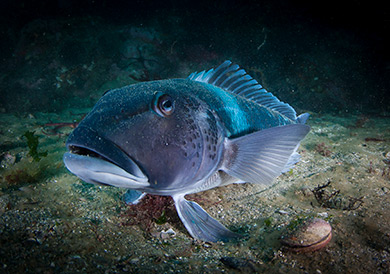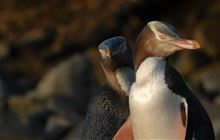Seafood species levels in Ulva Island-Te Wharawhara Marine Reserve
Introduction
Which seafood species are present in Ulva Island-Te Wharawhara Marine Reserve and how are their numbers changing?Ulva Island-Te Wharawhara Marine Reserve is an important nursery area for many species of fish. A 2014 survey identified 56 different species of fish in the marine reserve including blue cod, southern pig fish, gurnard, blue moki, skate, carpet shark and tarakihi.
Paterson Inlet has been a popular and highly valued fishery for blue cod, pāua and scallops as well as flat fish, mussels, tuatua, rock lobster, trumpeter and oysters.
A mātaitai reserve now surrounds the marine reserve and covers the whole of Paterson Inlet apart from Big Glory Bay. Mātaitai reserves recognise and manage traditional Māori fishing grounds and are developed and managed by local iwi/hapū with the Ministry for Primary Industries.
No commercial fishing is permitted in the mātaitai and there are additional limits for recreational fishing. The scallop fishery is also closed.
For details of the mātaitai visit the MPI website and search for ‘Te Whaka a Te Wera Mātaitai Reserve’.
Blue cod
Number of blue cod longer than 33 cm inside and outside Ulva Island-Te Wharawhara Marine Reserve
Number of blue cod shorter than 33 cm inside and outside Ulva Island-Te Wharawhara Marine Reserve

Blue cod at Ulva Island
Image: Vincent Zintzen ©
Download the data used in the graphs (XLXS,13K)
Status: undetermined
Natural levels of blue cod in the marine reserve are uncertain so their status cannot be assessed at this time.
Trend: undetermined
The last underwater visual census survey of blue cod was undertaken more than five years ago, so a trend cannot be reported at this time.
Overall, the number of blue cod in the marine reserve area has remained relatively constant, but the number outside the marine reserve has declined. In 2008 lower numbers were found than at any other time.
A 2014 baited underwater video study of 12 sites inside the marine reserve and 5 sites outside the marine reserve found more blue cod of all sizes inside the marine reserve.
Future surveys using this method would provide data to establish a recent trend.
Size differences
In the 1990s, no difference in the number of blue cod longer than 33 cm (the legal size for recreation fishing) was found at sites that would eventually be inside or outside the marine reserve. After the marine reserve was established, surveys found a greater number of large blue cod inside the marine reserve than outside.
A larger number of small blue cod (<33 cm) were found at sites that would eventually be outside the current marine reserve. Surveys after the marine reserve was established found similar numbers of small blue cod inside and outside the marine reserve. (This pattern is not unexpected: smaller fish are below the minimum size to be caught outside the marine reserve and are protected inside the marine reserve.)
Scallops
Paterson Inlet was closed to commercial fishing in 1994. It has been closed to all scallop fishing since 2001 due to concern about the decline in scallop numbers. A 2013 fisheries assessment surveyed 20 sites in Paterson Inlet for scallops (14 in the mātaitai, 3 in Ulva Island-Te Wharawhara Marine Reserve and 3 in Big Glory Bay). Some sites showed increased numbers of scallops compared with a survey in 2003.
Scallops are not found uniformly in Paterson Inlet – there are more in areas further from the entrance to the inlet. Also, the marine reserve does not contain large areas of the shallow water habitat preferred by scallops.
Blue moki
Number of blue moki inside and outside Ulva Island-Te Wharawhara Marine Reserve
Status: undetermined
Natural levels of blue moki in the marine reserve are uncertain so their status cannot be assessed at this time.
Trend: undetermined
The last survey of blue moki was undertaken more than five years ago, so we are unable to report a trend at this time. The number of blue moki at sites that would eventually be inside or outside the marine has remained relatively constant. A large increase in the number of blue moki at marine reserve sites was reported in 2006, but returned to a level seen in previous years in 2008.
Reports
- Ngā Tipa o Te Whaka ā Te Wera Mātaitai Stratified survey of the Paterson Inlet customary scallop (Pecten novaezelandiae) fishery 2013 (PDF, 765K). New Zealand Fisheries Assessment Report 2014/16.
- Relative abundance, size and age structure, and stock status of blue cod in Paterson Inlet of BCO 5 in 2010 (PDF, 2,380K). New Zealand Fisheries Assessment Report 2014/14.
- Distribution of the New Zealand scallop (Pecten novaezealandiae) within and surrounding a customary fisheries area. By Brenton Twist, Christopher Hepburn et al, 2015.
- Pecten novaezealandiae at its southern limit: habitat dynamics and ecology within Paterson Inlet, Stewart Island. Brenton Twist MSc thesis, 2015.
- Ulva Island-Te Wharawhara Marine Reserve BUV survey, 2014. Report prepared for the Department of Conservation by eCoast Limited (in preparation).
- Ulva Island-Te Wharawhara Marine Reserve Habitat mapping, 2015. Report prepared for the Department of Conservation by eCoast Limited (in preparation).
- Overthrowing a regime shift: displacement of sea urchins by abalone in a kelp forest ecosystem. By Stephen Wing et al, 2015.
- Baseline Ecological Monitoring of the Ulva Island/Te Wharawhara Marine Reserve (PDF, 1,320K). By Stephen Wing, 2006.

